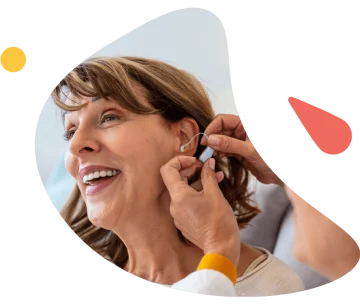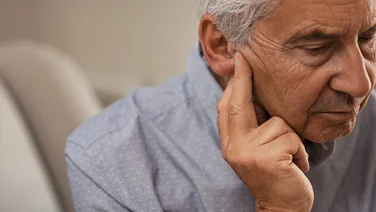Otosclerosis is a condition in which one of the three tiny bones inside the ear grows abnormally and becomes fixed in place.
On this page, you can find more information about the condition that most commonly begins to affect people in their 20s or 30s.
The medical definition of otosclerosis comes from the Ancient Greek terms ‘oto’ (of the ear) and ‘sclerosis’ (abnormal hardening of body tissue).
In otosclerosis, the fusing of the bone interrupts the process that enables you to hear, causing hearing loss.
Symptoms of otosclerosis usually start with gradual hearing loss that worsens over time. This is then followed by buzzing or ringing in the ears, dizziness, and balance problems.
Otosclerosis treatment depends on the degree of hearing loss, but it involves hearing aids as a first-line option and, if your hearing loss is severe, surgery.
If your hearing is starting to bother you, or is gradually getting worse, it’s always worth speaking to a professional. We can connect you with a local audiologist to get you the help you need. Fill in our quick form and we’ll do the rest.
What is otosclerosis?
Otosclerosis is a long-term condition that causes hearing loss. It’s conductive hearing loss that occurs when sound waves are blocked from moving through the outer or middle ear, stopping sound from reaching the inner ear.
More than 3 million people in the US have otosclerosis, but it’s particularly prevalent among white people of European descent, affecting around 1 in 10 adults in this group.
To understand what happens when you have otosclerosis, it helps to know a little about the structures of the ear and how hearing works.
The ear is made up of three main parts: the outer ear, middle ear, and inner ear.

The middle ear contains the eardrum and three tiny bones: the malleus, incus, and stapes, which are collectively called the ossicles.
When sound is produced, sound waves enter the ear canal (part of the outer ear) and travel to the eardrum, causing the eardrum and the ossicles to vibrate.
The vibrations pass the inner ear, and the cochlea then converts them into electrical impulses that travel to the brain. The brain then interprets these electrical signals as sounds.
In otosclerosis, abnormal bone tissue develops around the stapes. It usually starts at the foot of the stapes, where it attaches to the cochlea. As the abnormal bone tissue grows, it restricts the movement of the stapes, making it harder for the stapes to vibrate.
As a result, less sound is transferred to the cochlea and your hearing becomes impaired. Over time, the abnormal bone growth causes the stapes to fuse into place, leading to severe hearing loss.
Otosclerosis symptoms
Hearing loss is the main symptom of otosclerosis. It typically starts off mild, but it gradually gets worse. It can affect one ear (unilateral) or both ears (bilateral).
Some people’s hearing deteriorates quickly, while it takes a few years for others after they first notice hearing loss.

Some of the symptoms of otosclerosis are quite different from how other causes of hearing loss present. For example, if you have otosclerosis:
- You first have trouble hearing lower-pitched sounds and people whispering. This contrasts with other types of hearing loss, like noise-induced hearing loss, where the first signs are usually difficulty hearing high-pitched sounds.
- You tend to speak quietly. This is because the way otosclerosis affects your ears makes your own voice sound loud to you, unlike other types of hearing loss, where you may end up speaking louder because your own voice sounds softer or muffled.
- You find it easier to have a conversation when there’s background noise. With other types of hearing loss, having lots of noise around you – even just a few more people speaking at the same time – makes it more difficult to hear normal conversations.
Otosclerosis also shares symptoms with other hearing loss types, including:
Tinnitus
Often called ringing in the ears, but you can experience it as buzzing, humming, clicking, or whooshing-type sounds. Tinnitus is a common symptom of hearing loss, and around 80% of people with otosclerosis have tinnitus.
Vertigo
Feeling dizzy and as though you, or the room you’re in, are spinning around. Vertigo is less common in people with otosclerosis because it’s caused by a problem with a part of the inner ear that’s involved in balance. It is more typical of balance disorders, like Ménière’s disease.
Otosclerosis causes
We know that the bone tissue in our bodies constantly renews itself in a lifelong process that breaks down old bone and replaces it with new. This is called bone remodeling.
If you have otosclerosis, remodeling of the stapes bone in the ear goes wrong and new bone forms abnormally. It’s not known why this happens, or even why it affects the stapes in particular.
One possibility is that it’s related to cytokines (cells in the immune system) that are thought to be important in healthy bone remodeling. When the remodeling process is faulty – like in otosclerosis – it could be because levels of these cytokines are out of balance.
It’s likely there’s a genetic factor, too, because otosclerosis appears to run in families. If one of your parents has otosclerosis, the risk of you having it is 1 in 4 (25%). If both parents have it, the chances you’ll also develop it increase to 1 in 2 (50%).
However, some people with otosclerosis don’t have any family members with the condition.
Otosclerosis has been associated with viral infection, particularly the measles virus. There is some evidence that the decline in numbers of people with otosclerosis has coincided with a measles vaccination being introduced.
Experts think it’s likely that a combination of genetic and environmental factors determine whether you develop otosclerosis.
Otosclerosis diagnosis
If you have hearing loss or other symptoms of otosclerosis, you should visit an audiologist.
They will perform a few hearing tests to assess the degree of hearing loss and identify any other treatable contributing factors, such as blockage (wax, for example) in the ear canal.

There are no specific diagnostic tests for otosclerosis. Your audiologist might suspect you have the condition based on your symptoms and how they affect you. This is because the pattern of hearing loss is a little different from other types of hearing loss.
You might also have a CT scan or other types of tests to rule out other conditions and, if it’s confirmed you have otosclerosis, these tests will be able to identify how severe it is.
The outcomes of your tests will help determine the best treatment.
Otosclerosis treatment
There is no medication that can be prescribed to treat otosclerosis.
Some people have tried taking fluoride tablets to slow the progression of their condition. This is on the basis that fluoride can potentially help ease vertigo and balance problems as well as retain hearing. However, there isn’t much evidence as to this method’s effectiveness.
In its early stages, otosclerosis hearing loss can be improved by using hearing aids. They amplify sound, helping you to hear more clearly and they can make a big difference when your hearing loss is mild or moderate.
As otosclerosis progresses and your hearing loss worsens, the chances are you’ll need to have surgery.
The most common type of surgery is called a stapedectomy. This involves removing all or part of the stapes bone and replacing it with a prosthetic, allowing soundwaves to be processed as normal and restoring your hearing.
Otosclerosis surgery is quite straightforward and is usually very successful, restoring hearing completely in up to 95% of people. The results are normally long-lasting and less than 1% of people who have the surgery experience serious complications. You can usually go home on the same day.
However, stapedectomy surgery is delicate and not completely without risk. The surgery isn’t always successful and can even worsen hearing loss.
It’s important that you discuss the potential risks and complications with your doctor. Then balance them with any possible benefits to make an informed decision.








